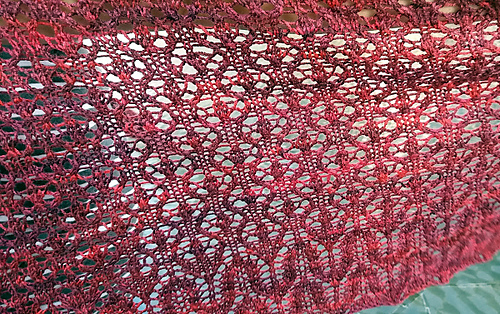patterns >  Alice Twain
Alice Twain
> Rosemary Plexiglas








Rosemary Plexiglas
https://www.youtube.com/watch?v=KzMYHJesU4g
The shawl has a pretty simple shape, the center is a traditional top down triangle, while the border increases abruptly by about the 15% and then no new stitches are created. The central triangle is knitted in a quite intricate pattern, which switches from a 6 to a 8 and back again to a 6 stitches repetition. This requires a bit of attention with the knitting, but once you get the hang of it and you start being able to “read” the stitch pattern.
The pattern is available in two sizes, the larger will produce a full-size shawl while the smaller, which only requires one hank of yarn, will produce a pretty small shawlette or kerchief which can be wrapped around the neck. Directions have been given for this smaller size, in brackets you can find the data for the larger one. If you want an even bigger shawl, follow the larger size directions but add even more (up to 14) Chart 1 repetitions, but do not make the border deeper as it has no increases past the setup row.
Lo scialle ha una forma piuttosto semplice, il centro è un triangolo top down tradizionale mentre il bordo richiede di aumentare improvvisamente del 20% circa le maglie, dopo le quali non ci saranno altri aumenti. Il triangolo centrale usa un punto relativamente complesso in cui il numero di maglie passa continuamente da un multiplo di 6 a un multiplo di 8 e di nuovo a un multiplo di 6. Questo richiede una certa attenzione, ma una volta capito il meccanismo diventa facile “leggere” il motivo e lavorare senza problemi.
Il modello è disponibile in due taglie, una più piccola per cui serve una sola matassa di filato e che produrrà uno scialletto utile come sciarpa, mentre la taglia più grande produrrà uno scialle piuttosto vasto. Le istruzioni sono relative alla taglia più piccola, tra parentesi troverete i numeri relativi alla taglia più grande. Se volete uno scialle ancora più grande, seguite le istruzioni per la taglia più grande aggiungendo ancora più ripetizioni del Grafico 1 (fino a 14 ripetizioni), ma non ampliate ulteriormente il bordo, dato che questo non presenta aumenti dopo i primi due ferri.
3 projects
stashed
3 times
- First published: September 2016
- Page created: September 23, 2016
- Last updated: March 14, 2018 …
- visits in the last 24 hours
- visitors right now





